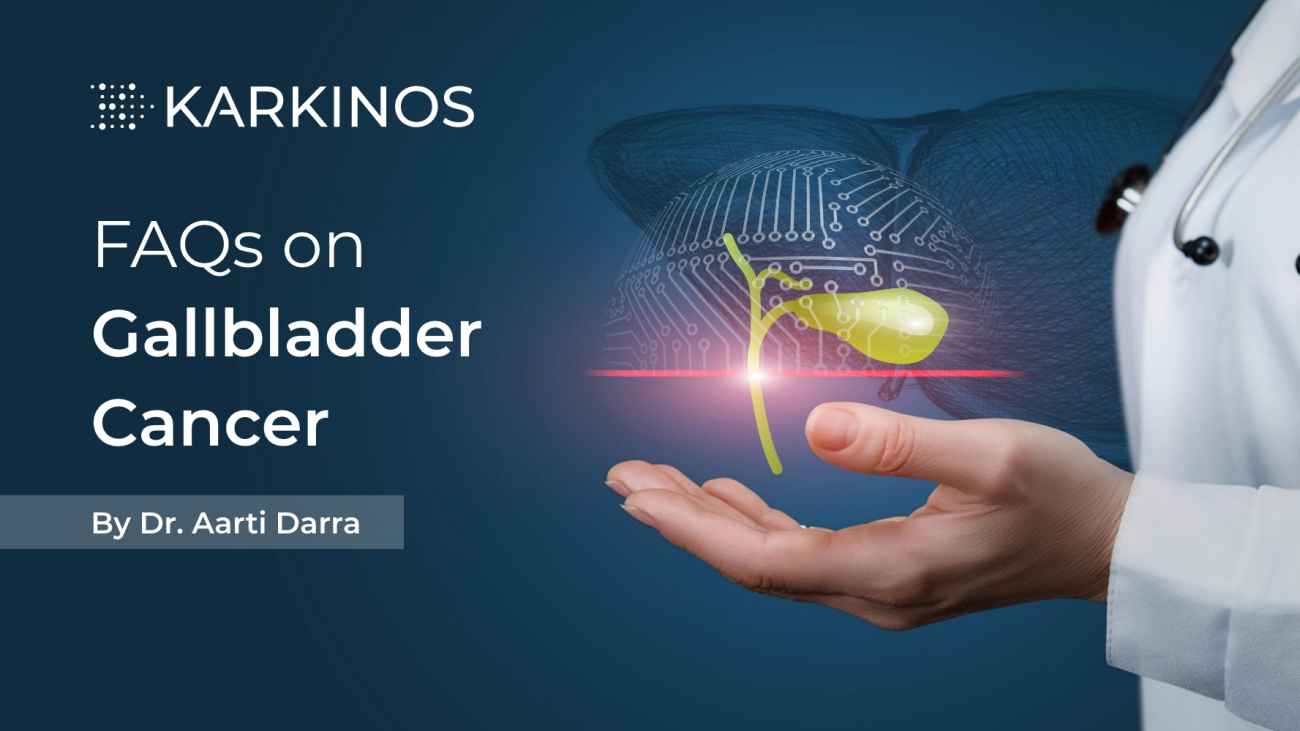FAQs on Gallbladder Cancer
By Dr. Aarti Darra, Bioinformatician, Karkinos Healthcare
What is Gallbladder Cancer?
Gallbladder (GB) is a small pear-shaped organ on the right side of the abdomen, located beneath the liver. It is responsible for concentrating and storing the bile synthesized by the liver to aid fat digestion.
India has one of the highest incidence of GB cancer, an otherwise rare cancer elsewhere in the world. It is estimated that India contributes to ~ 10% of the global GBC burden (1). As per trends and patterns of top ten common cancers in India. GBC is the most common cancer registered between 2014 & 2021 (2).
A number of risk factors have been associated to confer a risk for developing GB cancer. This includes cholesterol gallstones, exposure to heavy metal, Helicobacter and Salmonella typhi infection. Within India, the highest density is observed in the Indo-Gangetic belt, covering northern India and shows high preponderance in Indian women. History of gallstones with inflammation (cholecystitis) increases the risk many-fold.
How is GB Cancer diagnosed?
The nature and location of gallbladder in the body would mean that gallbladder disease can remain undiagnosed in early stages and therefore gallbladder cancer is notorious by its late identification. Additionally, gallbladder cancer is associated with rapid progression and poor survival rates. Since the causal factors are not yet determined, no defined preventive strategy exists. Late diagnosis often with involvement of adjacent organs, the liver, the pancreas and the duodenum would mean that it becomes difficult to surgically resect the tumor.
The clinical suspicion largely comes from the symptoms of involvement of the gallbladder or adjacent organs. The suspicion could be further confirmed up usually using one of the imaging modalities including ultrasonography and is usually also followed up with a computed tomography or a magnetic resonance imaging. These modalities are usually non-invasive and pain-free. In complicated cases, additional invasive modalities like cholangiography, where a dye is injected into the bloodstream which will spread to the liver, bile duct, gall bladder and intestines under no blockage conditions.
How can genomics help understand and manage GB cancer?
In 2022, European society of molecular oncology (ESMO) published clinical practice guidelines for Biliary Tract Cancer (3). The guidelines suggest administering chemotherapy agents; Cisplatin-gemcitabine-durvalumab in the first line of therapy. The second line of treatment includes 5-fluorouracil-leucovorin-oxaliplatin (FOLFOX), administered after testing negative for DPYD gene. Often the patients are diagnosed at an advanced stage, hence the response is poor.
Alternatively, performing molecular analysis before or during the first line of therapy is a part of the recommended guideline. This includes testing for genomic differences in genes that can be targeted. The drugs Ivosidenib, Pertuzumab-trastuzumab and Dabrafenib & Trametinib target mutations in IDH1/IDH2, HER2/neu and BRAF genes respectively. Patients positive for HRR are suitable for PARP Inhibitors and those with high MSI qualify for Pembrolizumab. The fusion of therapeutic value like NTRK and FGFR2 also constitute a treatment modality for BTCs.
Where are we and where are we going?
Most people Patients with GBC do not experience any symptoms and a non-availability of a diagnostic test abrogates the early diagnosis and disease management. GB is resectable but surgical intervention is non-uniform and rate of recurrence is high.
Genomics can direct the roadmap that could lead to early diagnosis. Research shows that at least one potential targetable mutation is identified in 30-50 % of GBC patients, making it druggable and 3-5 % show TMB-high (>10 mutations/Mb), a criteria suggestive of immunotherapy. In relation to family history of malignancies, 2 out of 60 patients were found to harbor germline mutations in genes ATM and BRCA2.
Screening high risk individuals will construct the genomic features unique to Indian GBC patients and help us dig tumor agnostic mutations in candidate genes. Currently, the diagnosis relies on non-invasive auxiliary imaging or invasive laparoscopy or biopsy. Thereby, introducing the need to formulate a diagnostic and a prognostic marker using genomics data for early disease management.
References:
- https://pubmed.ncbi.nlm.nih.gov/31484488/
- Raj S, Sinha DK, Madhawi R, Devi S, Kishor K, Singh RK, et al. Trends and patterns of top ten common cancers in Eastern India from 2014 to 2021: A retrospective hospital‑based cancer registry data update. Indian J Community Med 2024
- https://www.esmo.org/guidelines/guidelines-by-topic/gastrointestinal-cancers/biliary-tract-cancer

 I am a Bioinformatician working at Karkinos Healthcare, and my dedication extends beyond routine clinical responsibilities, with a particular emphasis on contributing to the betterment of patient outcomes.
I am a Bioinformatician working at Karkinos Healthcare, and my dedication extends beyond routine clinical responsibilities, with a particular emphasis on contributing to the betterment of patient outcomes.